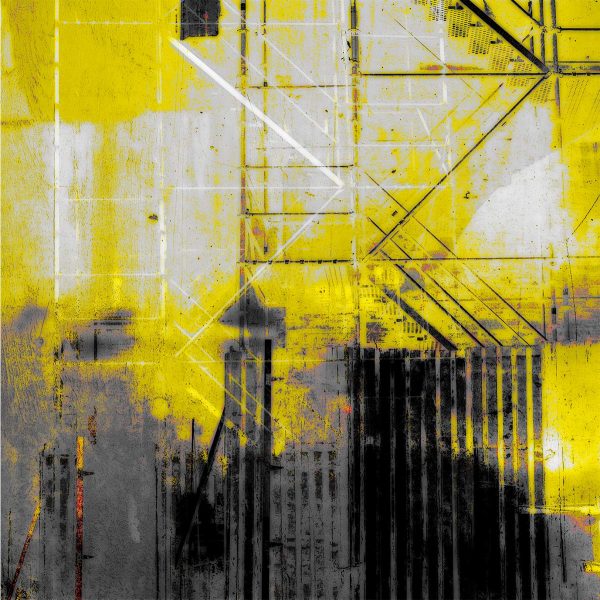
Today I am excited to show some new additions to the Scaffold series. At construction sites I am always drawn to the scaffolding around buildings. I am fascinated by their diagrammatic quality, and the way they point to geometric systems in simultaneous plan view and elevation. They layer a grid of abstraction over the landscape of the built environment, with infinite variation. They are both a structure and a space: mostly space, enclosed by tenuous lines that can hold up a fleet of construction workers or a wall or the hull of a ship on shore. They are filigree and lattice, ornament and infrastructure.

When construction projects are draped in tarps it is like a huge theater project. The
massive fabric becomes an archetype of the feminine, laying an atmosphere of mystery and sensuality over the hard grid. As I worked on “Sari Scaffold” it began to resemble the silk threads of a sari.

What I love about the scaffold theme is not just its abstract qualities, but its metaphors. If you build anything, whether it’s a house or a life, you need a structure to hold it up as you go. The structure can be a set of words, a song, a belief, or a beam you actually stand on while you reach. Sometimes the scaffold is simply a question. What if I walk out on the edge? What if I fall? And what will I see as I grab the rope and hang out in space seeing things I would never see any other way?

You could say the stair is the birth of the scaffold. This particular stair lived for about a year behind the opera house as it was being demolitioned and rebuilt. One day it disappeared – or perhaps it gave birth to a latticework of stairs that reach to the sky.

As I dive deeper into the ways digital print making can resemble the granular characteristics of the analog printing press I also stumble into territories far out of the spectrum of the printable color wheel. That would be called “out of gamut color” that lives only in the shifting universe of a monitor. It can be maddening to spend a day refining electrifying color combinations only to discover they will not print. The “out of gamut warning” on a computer shows a particular silvery gray where every unprintable color lives. I realized as I stopped weeping in frustration it was actually one of the loveliest grays I’ve ever seen: why not subvert it and work with it? Which led to the above print, now one of my favorites.


The last three in the series go back to photographic origins, while thinking in terms of etching and collagraphy, a technique pioneered by Glen Alps in 1955 and further developed by many contemporary printmakers. A collagraph is built with layers of relief made from cardboard, shellac and other materials, inked with brayers and brushes. When I practiced this technique I always liked the plate much better than the print, and these pieces evoke those richly messy and textural surfaces. These are the first prints from a series based on the Aurora Bridge repair project, a massive undertaking with one of the best tarp installations in the city. I always look forward to being trapped in traffic on the Fremont Bridge so I can study it. Help me with naming the series here: Fremont or Aurora? Both wonderful evocative names, and both true.



These last three prints are not yet listed in my shops but will be soon. The links in the titles of the others will take you to my shop on SaatchiArt. Additional prints from the series are available here. Sizes range from an image size of 15 x15″ to 30 x 30″ and are priced from $350 to $1,700 depending on sheet size and edition size. I am happy to show you work in person if you would like to schedule a studio visit. The fine textures can be a challenge to replicate onscreen.
Upcoming Shows and Other News
I am starting work on pieces for a group show at SAM Gallery, “Artists Influenced by Asia,” opening this November. I think they will be landscape oriented, but whether that’s a landscape of the mind or the known world I don’t know yet. Ah, the Unknown . . . As a tango teacher once told me, “If the Follow doesn’t know what comes next, she relaxes.” Working on that, while leafing through a favorite book on the subject, Maira Kalman’s The Principles of Uncertainty. The time in between shows this year is filled with experimenting in the studio, documentation of various infrastructure projects around town, and a commission I hope to share with you next time (7 feet long (!).
I have also been teaching social media classes, most recently at the University of Washington, and doing private consultations with artists and other creative people trying to make sense of the media options in our modern circus. Give me a shout if you would like to do a one on one session or gather a few people to meet at my studio. The next official class will be at VIVA on Vashon Island in the fall.
I post new work frequently on social media. Follow my studio practice and give me your thoughts on work in progress on Instagram and Facebook.
Leave a Reply